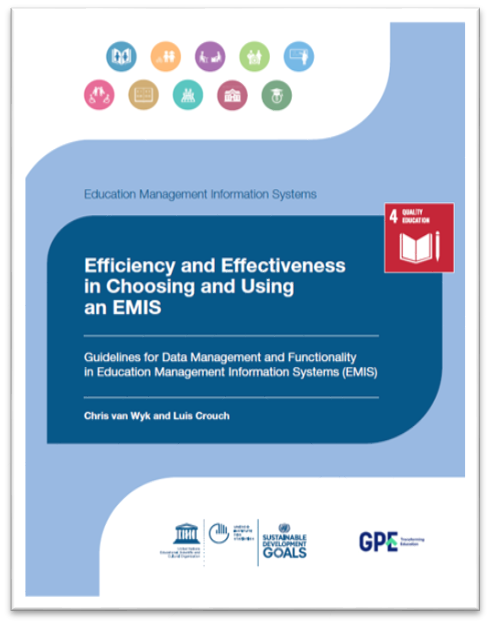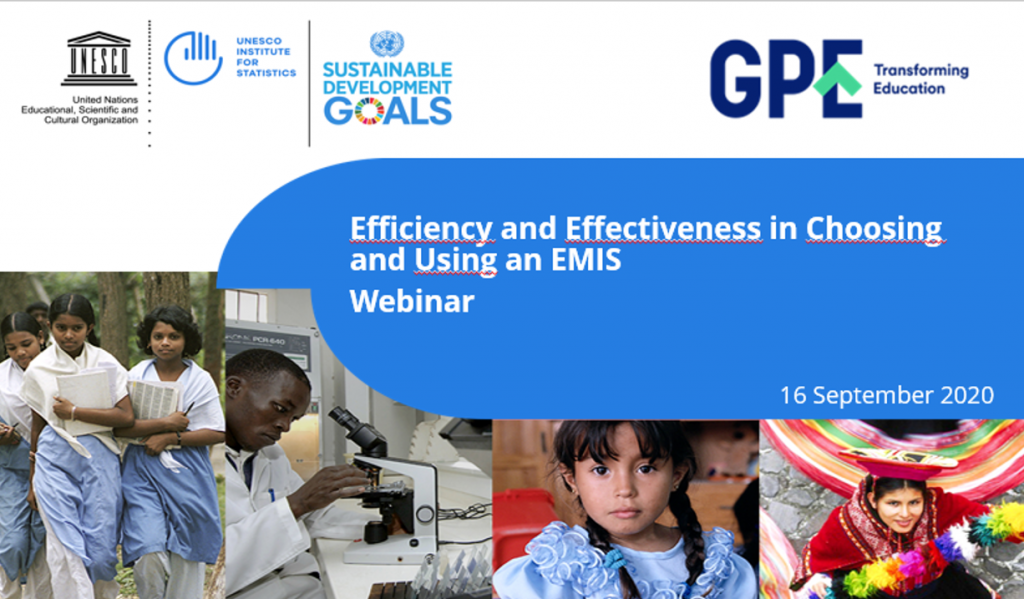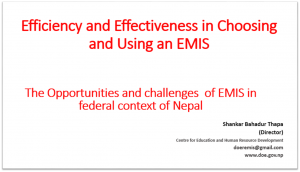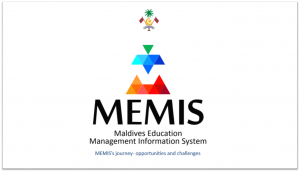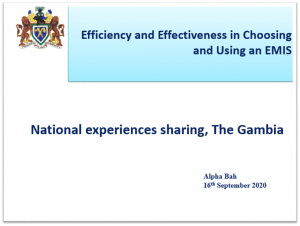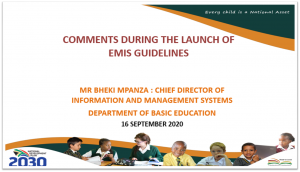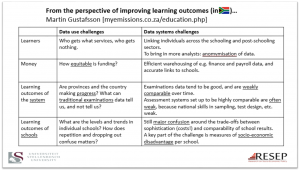
The UNESCO Institute for Statistics (UIS) and the Global Partnership for Education (GPE) are proud to present the fruit of their collaboration in optimizing Education Management and Information System (EMIS) for the monitoring of SDG 4 indicators with the newly launched guide:
The Efficiency and Effectiveness in Choosing and Using an EMIS. Guidelines for Data Management and Functionality in EMIS – essentially a “Buyer’s Guide” and a “User’s Guide” to EMIS - answers the needs expressed by countries for guidance from the international community.
-
-
-
-
-
-
-
-
- How to improve their EMIS; including at the technical level in discussions with development partners wishing to contribute to the development of countries’ data for education.
- It also serves as a way to specify a standardized default EMIS platform, or act in lieu of such a platform.
-
-
-
-
-
-
-
The Guide was announced during a webinar organized by the UIS and GPE on 16 September 2020. The event brought together countries, key stakeholders and regional organizations, inviting all to engage in a conversation on countries’ experiences in the implementation, use, and challenges they face.
Silvia Montoya, Director of the UIS, and Alejandro Jose Palacios, Director for North America, the Private Sector and Foundations at GPE, welcomed all participants to the event, attended by over 200 people from all over the world.
The authors of the guide, Dr Chris van Wyk and Luis Crouch, offered a summary of their work before invited representatives of the Gambia, the Maldives, Nepal, and South Africa discussed their various experiences and challenges in implementing, operating and using national EMIS. Each of their individual experiences provided the audience with a variety of settings in which EMIS are used to report on national education, leading to a rich Questions and Answers (Q&A) session, moderated by Margaret Irving, an education Economist at GPE Secretariat.
Lastly, the UIS took this opportunity to introduce and show a preview of their new supporting tool for the use of EMIS to report on SDG 4, the EMIS microsite.
This webinar is the first of a series to be announce in the coming weeks, and which will bring to the discussion multiple themes including:
- the launch of an Operational Guide
- opportunities and challenges associated with existing school, student and teacher ID systems
- possible mechanisms and strategies for effective donor (development partners) coordination of EMIS activities for countries
- challenges of various EMIS softwares and ways to integrate them
- how to develop “Minimum Standard” of EMIS software (e.g. internal verification mechanisms)
- other topics such as capacity-building on education statistics and role of UIS
- how to optimize the EMIS microsite to improve the collection, compilation, reporting and the use of education data
You can view the recording of the webinar here.
Efficiency and Effectiveness in Choosing and Using an EMIS. Guidelines for Data Management and Functionality in EMIS
by Dr Chris van Wyk, Researcher at Stellenbosch University in Department of Economics, South Africa
Luis Crouch, Former Chief Technical Officer GPE, GPE Senior Consultant, UIS Board member and advisor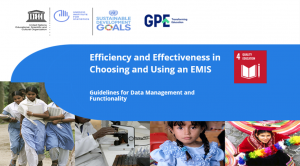
Perspective of Improving Learning Outcomes
by Dr Martin Gustafsson, Education economist, Stellenbosch University, South Africa
Questions & Answers
During the webinar, speakers answered a number of questions...
There are many ways to do it. One is verifying the data from the origin of data. One can do this systematically through random sample audits, or through complete audits. One can also do it analytically by comparing to previous years’ data school by school and for checking for surprising inconsistencies. The main benefit of using data is for effective monitoring for targeted interventions. One also needs to consider that not all uses of data demand the same level of accuracy. Data needed to answer questions such as “In what regions of the country does dropout seem to be higher and what are the approximate causes” demand data can use data that could be less accurate than the data needed to, say, make financial allocations to districts. So one has to consider the use and there may be levels of approximation that are acceptable, depending on the use.
Many countries, especially developing countries, have a problem with internet connectivity. In those cases they can use both online (in bigger cities, say) and offline (in more rural areas) to collect data. Data are collected from remote location on offline or through paper and these are entered into the computer where internet and facilities are available. Thus, in remote areas entry might take place only at the district level, say. Same thing for sharing back with schools. In remote areas, school report cards could be printed at district level and distributed to schools. In cities, the school report cards could be sent directly to the schools. The issue of bandwidth also affects whether one uses simpler tools such as e-mail combined with Excel, or true web-based data entry and distribution.
Although we may want to integrate the data as far as possible to answer key policy questions, we have a challenge when it comes to protection of data.
Most the countries are integrating databases based on “common field” (that is, a common ID for schools or, in some cases a common ID for teachers and/or pupils) from one sub-system (e.g., exams, finances, and classical EMIS) or data set to other. Some countries are using integrated EMIS including different module into the main system. If data are in common platform it is not difficult to integrate it and data should be stored into ‘standard’ software and hardware. Establishing and maintaining a consistent ID system, it has to be admitted, is not a trivial task especially as one moves to the student and/or teacher level. But the task simply requires persistence and work, more than fundamental research.
See previous question
UIS provides support based on available resources and based on case-to-case basis UIS provides support to establish functional EMIS. It also brings experience of other countries and evaluation of existing system and future requirements.
Yes, it could be done, depending on the demand.
The Guides are different from SABER or DQAF. Those tools are developed to evaluate existing EMIS. If an analogy helps, guides such as SABER can pinpoint issues, much as the dashboard lights in a car can suggest there is an issue with the engine. But only the mechanics’ manual can usually tell how to fix it. The Guides are more like a mechanic’s manual.
There are many ways. One could make provision to retrieve and use data from different sources – household survey, learning assessments, education expenditure data, administrative data and population data. The Guide suggests the mechanics of this. It is suggested to develop an interface to covert data into indicators in modular basis and based on availability of data and its format. Institutionally of course this integration requires effort and budget, which is why the Guide also notes the importance of having an EMIS or more broadly an education data policy that commits Ministry management to the effort needed to carry this out. It is also somewhat up to the EMIS unit to market the importance of this effort by noting the insights that it can produce for the upper management of the Ministry.
Yes, it is hosted in online platform and the software has also checking and verify internal consistency data and also check with school record. No, it does not collect data through by emails but by using MEMIS.
It supports other languages. But Maldives is using English only, as that is the medium of instruction in Maldives and schools are familiar with English.
It is not three distinct databases, but the data have three layers of databases. Once the school sends data it automatically goes to all three levels (district, province, and national) or layers of data. The government has allocated resources and also developing a comprehensive training module is being developed.
Yes, it can be used in this way, and many countries are doing so. Nepal, Maldives, and South Africa are examples, as given during the webinar.
OpenEMIS is an open resource planform.
It is suggested to map the countries’ needs and, based on the requirements, it is suggested to choose the technology. An important consideration is how the technology platform can be made to run independently, not relying much on external support for day to day management.
There are many ways. One could make provision to retrieve and use data from different sources – household survey, learning assessments, education expenditure data, administrative data and population data. The Guide suggests the mechanics of this. It is suggested to develop an interface to covert data into indicators in modular basis and based on availability of data and its format. Institutionally of course this integration requires effort and budget, which is why the Guide also notes the importance of having an EMIS or more broadly an education data policy that commits Ministry management to the effort needed to carry this out. It is also somewhat up to the EMIS unit to market the importance of this effort by noting the insights that it can produce for the upper management of the Ministry.
There are many ways. One simple way to compare with historical data and also compared with other related indicators. Regarding triangulation, it should be compared with other sources e. g. administrative and household data. However, one should be keep in mind the methodologies, data collecting timing etc.
This can only be answered on a case by case basis and by those with knowledge of the country in question, and with knowledge of the development partners’ activities in the specific countries. It would be dangerous so answer this question generically but in principle it should be possible, again, depending on the case.
Some form of mapping is better. At a minimum the precise location and the means to find the school should be included. But the geolocation (the geographical coordinates) is an extremely powerful tool, especially if embodied in a Geographical Information System (GIS) that can collate this information with, for instance, road information, information on settlement density, etc. Also, without mapping and listing schools by location it is difficult to ensure the quality of data. Many countries do not have a master list of schools and many non-recognized, private, community, or religious schools are not counted. The response rates from private schools are low in many developing countries. This is why sometimes household survey data show enrolment patterns that are different from what EMIS shows.
